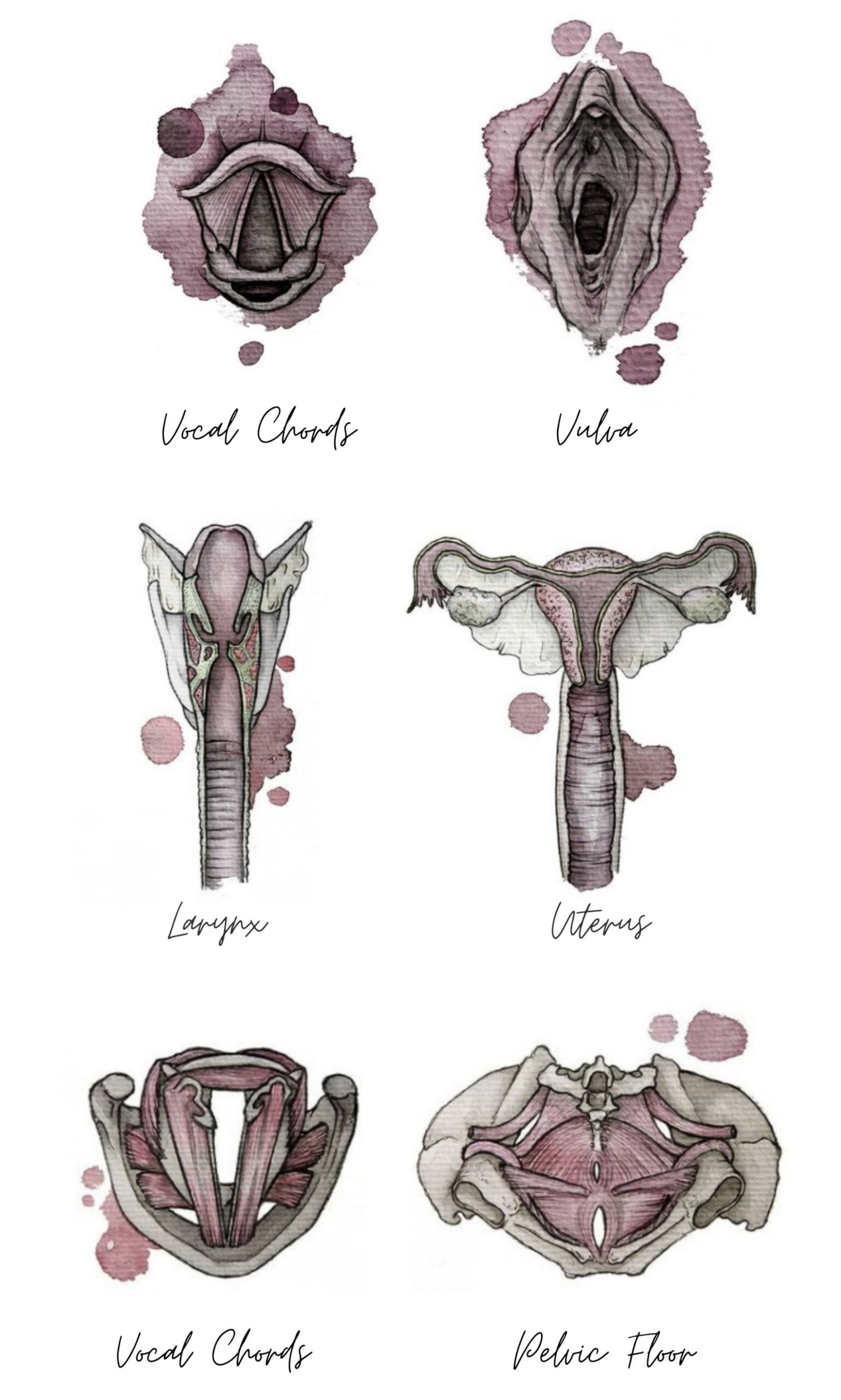
None of my five babies ever liked to be shushed to sleep. Instead, deep humming was their preferred noise. They would lay their heads on my chest, finding comfort in the vibrating guttural sounds and the beat of my heart. Turns out, there is something to be said for this type of noise-making or vocal toning.
Vocal toning and breathing techniques can help induce calm, ease anxiety, and distract from pain and prove beneficial in labor.1 If you’re looking for how to ease contraction pain, using vocalization in labor is helpful. Read on to discover how the pelvic floor, diaphragm, and vocal cords perform.
Your Pelvic Floor, Respiration, and Vocal Toning
There is minimal research specifically linking the muscles of the pelvic floor, the motion of breathing, and the impact of vocal toning. But let’s explore some body mechanics to find the link.

The Motion of Breathing and the Pelvic Floor
The diaphragm, located below your lungs, is the primary muscle used for breathing. During inspiration, the diaphragm contracts. During expiration, the diaphragm relaxes.2 The contraction of the abdominal muscles and changes in intra-abdominal pressure (IAP) — the state of pressure within the abdominal cavity — affects the diaphragm’s motion.
Studies confirm the link between IAP changes and the contraction and relaxation of the pelvic floor muscles (PFM). The PFM, the abdominal muscles, and the diaphragm are responsible for reacting to and controlling changes in the IAP. The strength and stability of your PFM correlate to adequate control and the efficacy of your breath.2
The Pelvic Floor During Labor
The pelvic floor is a collection of muscles and tendons that form a sling to support the organs of your reproductive and urinary systems. Your PFM generally relaxes during inspiration and contracts during exhalation.2 PFM relaxation is necessary during labor to make way for a baby’s descent and, ultimately, a vaginal birth.6
What is Vocal Toning?
Vocal toning uses your voice to produce sounds of grunts, moans, and groans, as well as open vowel sounds like “ohhhhh” or deep humming while slowly exhaling.1,3 Data supports that successful vocal toning induces a “meditative” or “calm” awareness or consciousness.1
Pulling It All Together
When we are scared, stressed, or in pain, our breathing patterns may change in a way that is not beneficial for the body in labor. Hyperventilation (breathing too fast and shallow), holding your breath, and high-pitched noises do not allow pelvic floor relaxation.2 Holding tension in the body due to pain, fear, and anxiety will also inhibit pelvic floor relaxation.
Labor coping becomes a marriage of pelvic floor relaxation and breathing, which can be achieved with vocal toning.
Why Vocalize During Labor?
Now that we have all those fun biological details sorted out, why is it beneficial to vocalize during labor? Vocal toning and controlled breathing have physiological and psychological impacts essential in labor.
Oxygen is necessary for you and your baby, and labor increases the demand for oxygen for both of you.4 Vocal toning with open vowel sounds has been shown to slow down the rate of breathing while significantly increasing the volume of air moved and heart rate variability — all good things while your body copes with the stress of labor.5 A relaxed throat, achieved with an “ohhhh” sound, also means a relaxed perineum. Vocal toning intensifies the connection between the pelvic floor, diaphragm, and vocal cords.
Psychologically, vocal toning can induce a calm, mindful state that combats stress and anxiety.1 It is often used during meditation for that purpose.
Vocal Toning: How To Do It
Vocalization in labor may seem intimidating. The noises of loud moaning to deep groaning often sound intimate and primal. Vocalizing during labor feels instinctual for many, but you may hesitate for others to hear you. Rest assured, labor nurses have heard it all. Begin practicing while pregnant to find the sound that relaxes you the most.
First, use your fingers to find the notch at the bottom of the throat but above the chest bone. Take in a deep abdominal breath. As you exhale, make a low humming noise. Feel the vibrations in your fingertips. Change the pitch of your humming or moan and notice how it relaxes your throat and body.3
How To Make Yourself Moan for Perineal Control
Relaxing your pelvic floor muscles seems counterintuitive. The practice takes focus and calm, which may be challenging in labor. But the benefits of controlling and relaxing your perineum simultaneously can help you achieve a vaginal birth. And, of course, practice makes perfect.
- Inhale deeply and do a kegel at the same time.
- Exhale slowly through your mouth, and vocalize an “ohhhh” sound while releasing your bottom.
Try changing your “ohhhh” to “ahhhh.” Does this change things? Imagery may also be helpful in this practice. As you exhale, imagine your pelvis opening, exhaling out of your vagina.3
Your vocal toning sound variation, depth, and pitch will be very individual. They may even change throughout labor. You may find that deep sounds are better for easing contraction pain. Your moans may become deeper as contraction pain intensifies. Do not be afraid to experiment to see what tone works for you at different stages of your labor.
Labor sounds are as variable as people. Find your confident voice to cope with the sensations, fears, anxieties, and pain of labor. Let your voice wash over you as you ride the ebb and flow of contraction waves.
from Baby Chick https://ift.tt/3YQSuh7
via IFTTT


0 Comments
Please ,
Don't enter span link ...